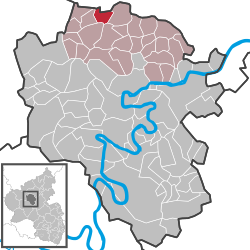Urmersbach
| Urmersbach | ||
|---|---|---|
|
||
| Coordinates: 50°15′27″N 7°7′55″E / 50.25750°N 7.13194°ECoordinates: 50°15′27″N 7°7′55″E / 50.25750°N 7.13194°E | ||
| Country | Germany | |
| State | Rhineland-Palatinate | |
| District | Cochem-Zell | |
| Municipal assoc. | Kaisersesch | |
| Government | ||
| • Mayor | Reiner Weber | |
| Area | ||
| • Total | 4.34 km2 (1.68 sq mi) | |
| Elevation | 420 m (1,380 ft) | |
| Population (2015-12-31) | ||
| • Total | 443 | |
| • Density | 100/km2 (260/sq mi) | |
| Time zone | CET/CEST (UTC+1/+2) | |
| Postal codes | 56761 | |
| Dialling codes | 02653 | |
| Vehicle registration | COC | |
| Website | urmersbach.kaisersesch.de | |
Urmersbach is an Ortsgemeinde – a municipality belonging to a Verbandsgemeinde, a kind of collective municipality – in the Cochem-Zell district in Rhineland-Palatinate, Germany. It belongs to the Verbandsgemeinde of Kaisersesch, whose seat is in the like-named town.
The municipality lies in the Eifel roughly 2 km north of Kaisersesch and 10 km southwest of Mayen.
In 1787, the area within municipal limits was 361 ha, and in 1789, it was given as 623 Morgen. In 1925, it was quoted as being 433 ha, and today it is slightly bigger at 434 ha.
In 1253, Urmersbach had its first documentary mention. Beginning in 1794, it lay under French rule. In 1815 it was assigned to the Kingdom of Prussia at the Congress of Vienna. Since 1946, it has been part of the then newly founded state of Rhineland-Palatinate.
The oldest population figure comes from 1612 and gives the village’s population as 11 incolae, that is to say, families, which suggests roughly 70 persons. In 1784, Urmersbach counted 233 inhabitants, and by 1910, 508. The population changed very little over the Second World War, falling from 471 in 1939 to 465 in 1950. On 31 December 1999, 229 families were living im Urmersbach, comprising 510 persons, of whom 261 were female and 249 male.
The council is made up of 8 council members, who were elected at the municipal election held on 7 June 2009, and the honorary mayor as chairman. The eight seats on council are shared between two voters’ groups.
...
Wikipedia



